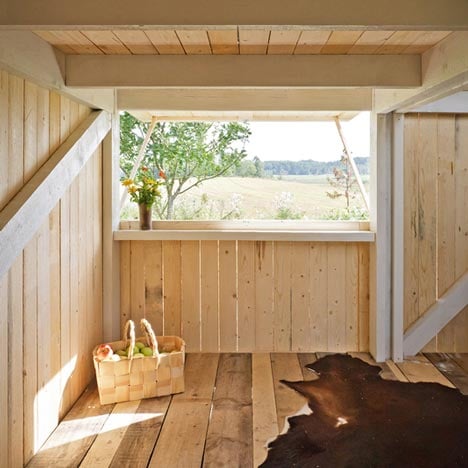This children’s playhouse by Barcelona architects Anna and Eugeni Bach has stripy wooden walls, folding window hatches and a ladder instead of stairs.
The architects designed and constructed the folly at their parent’s farm in southern Finland, following a request from their children for a house of their own.
Assembled from nothing but locally milled spruce, the structure comprises two connected modules with roofs that pitch in different directions.
One side of the playhouse contains a double-height room, while the opposite half comprises two storeys.
We've also previously featured a playhouse inside a clothes store - take a look here.
Photography is by Tiia Ettala.
Here's some more text from Bach Arquitectes:
Playhouse
When an architect couple has young kids, there will arrive a day when they ask:
- Mom, dad… You´re architects, aren't you?
- Yes…
- And you make houses for people?
- Yes, of course…
And then comes the key question:
- So why don't you do a house for us?
In such a situation, there are two possibilities: find an excuse to avoid it, or promise them that you will make a house especially designed for them.
We found ourselves in this stuation last summer, and we promised them that we would build a house for them on their grandparents farm in Finland. And, of course, at the kids insistence we fulfilled our promise.
The cottage is mainly based on a section: the structure is very simple, repeated in two equal modules but oriented in opposite directions. One of these modules is double-height (to the scale of children), which allows an adult to enter the house without having to bend. The other module has two levels, connected by a simple ladder allowing a more complex game inside.
This simple starting point means that from the outside, the house acquires the presence of an almost abstract object, without reference to the scale; while inside, when crossing the two modules you can identify the prototypical section of a childish house, with the typical symmetrical roof, like those we drew ourselves when we were kids.
The interior becomes what children understand as an essential house: a larger space that could be the living room, a lower space where the kitchen could be imagined and a higher ground where there could be the rooms. The abstract nature of the interior spaces allows a child´s imagination to flow, and those spaces that could be identified as a domestic interior can suddenly become the dungeon of a medieval castle, or the attic in the main tower from which to shoot arrows at enemies.
The construction of the house took two weeks. It was all built by two persons (ourselves, plus two little helpers), and was an educational process as rewarding as pedagogic: children saw and understood that things are achieved with effort, and that you can build your own dreams.
For the structure and the floors we used spruce wood from the grandparent´s farm, from trees planted by the kids´ great grandfather and cut by their grandfather. The rest of the wood was bought at the hardware store, from small wood sawmills in the area.
The whole house is made of wood; structure, floors, walls and roof, using traditional construction techniques used in Finnish barns such as leaving a nail distance between slats to ventilate the house, or a roofing system made from a simple overlapping of grooved wooden planks to prevent the ingress of water.
Only a small galvanized flashing helps protecting the wood cuts at the facades.
The house was painted with vertical white stripes, which persist on the roof and help to explain the original section of the project. The rest of the wood is left untreated, so that over time it will take a grayish hue that will increasingly contrast with the painted surfaces, showing more obviously as time goes on, and also symbolising how children get older.
These strips give a festive character to the volume, likening it to a fair house or an old beach changing hut, although in this case, its location in a rural environment, surrounded by apple trees, adds a more dreamlike character.
Author: Anna & Eugeni Bach, architects
Collaborators: Uma and Rufus Bach
Project dates: From July 20th to July 21st 2011
Work site dates: From August 10th to August 24th 2011
Built surface: 13,50 m2
Budget: 800 €
Promoter / owner: Uma and Rufus Bach
Constructor: Self built (Anna & Eugeni Bach)
Address: Pälölä farm, Nummi Pusula, Finland.

